

Undenatured Whey Protein & Glutathione. Glutathione is the most important antioxidant available to your immune system, according to Dr.

Mark Hyman in an article for the "Huffington Post. " Your body makes glutathione, but many factors contribute to its depletion. Including foods that are precursors to glutathione in your diet is a better way to increase levels of the antioxidant than taking supplements. Hyman recommends undenatured whey protein for efficient glutathione production. Antioxidants work in your body to counteract free radicals, which cause cellular damage that results in a variety of health conditions. Undenatured whey protein aids in glutathione production because it contains cysteine, an amino acid that builds the antioxidant in your body.
Undenatured whey protein is sold in many health food and vitamin stores in powder form. Despite its benefits for increasing glutathione levels, undenatured whey protein is not right for everyone. Dr. CHENEY ON UNDENATURED WHEY. International : Good Manufacturing Practices (GMP) Acidosis. Acidosis | Page: 3 Continue Reading...
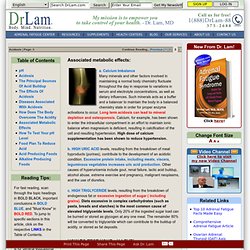
Previous | 1 | 2 | 3 | Reading Tips: For fast reading, scan through the topic headings in BOLD BLACK, important conclusions in BOLD BLUE, and "Must Know" in BOLD RED. To jump to specific sections in this article, click on the respective LINKS in the Table of Contents. Information presented here is for general educational purposes only. Associated metabolic effects: a. Adaptogenic Herbs. Thanks to the Nutrition Science News for access to this article!
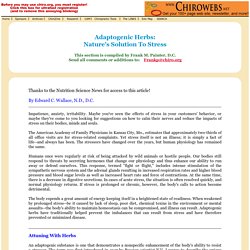
By Edward C. Wallace, N.D., D.C. Hibiscus tea. Dried hibiscus calyces.

Active compound[edit] Formaldehyde. Formaldehyde is a naturally-occurring organic compound with the formula CH2O.
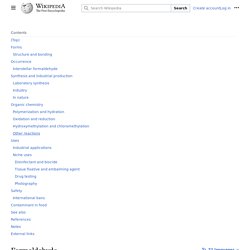
It is the simplest aldehyde and is also known by its systematic name methanal. The common name of this substance comes from its similarity and relation to formic acid. Formaldehyde is an important precursor to many other materials and chemical compounds. In 1996, the installed capacity for the production of formaldehyde was estimated to be 8.7 million tons per year.[7] It is mainly used in the product of industrial resins, e.g., for particle board and coatings. In view of its widespread use, toxicity, and volatility, formaldehyde is a significant consideration for human health.[8] In 2011, the US National Toxicology Program described formaldehyde as "known to be a human carcinogen".[9][10][11] Forms of formaldehyde[edit] Occurrence[edit] Processes in the upper atmosphere contribute up to 90% of the total formaldehyde in the environment. Aspartame. Aspartame (APM; /ˈæspərteɪm/ or /əˈspɑrteɪm/) is an artificial, non-saccharide sweetener used as a sugar substitute in some foods and beverages.

In the European Union, it is codified as E951. Aspartame is a methyl ester of the aspartic acid/phenylalanine dipeptide. It was first sold under the brand name NutraSweet; It was first synthesized in 1965 and the patent expired in 1992. The safety of aspartame has been the subject of several political and medical controversies, congressional hearings and Internet hoaxes[3][4][5] since its initial approval for use in food products by the U.S.
Food and Drug Administration (FDA) in 1981.[6]:2 A 2007 medical review on the subject concluded that "the weight of existing scientific evidence indicates that aspartame is safe at current levels of consumption as a non-nutritive sweetener".[7] However, because its breakdown products include phenylalanine, aspartame must be avoided by people with the genetic condition phenylketonuria (PKU). Chemistry[edit] Xylitol. Xylitol is naturally found in low concentrations in the fibers of many fruits and vegetables, and can be extracted from various berries, oats, and mushrooms, as well as fibrous material such as corn husks and sugar cane bagasse,[7][8] and birch.[9] However, industrial production starts from xylan (a hemicellulose) extracted from hardwoods[10] or corncobs, which is hydrolyzed into xylose and catalytically hydrogenated into xylitol.

A study in rats found that xylitol had reduced or nonexistent side effects compared to other artificial sweeteners, and lower caloric value and cariogenicity than sucrose.[11] Production[edit] Xylitol was discovered almost simultaneously by German and French chemists in the late 19th century,[12] and was first popularized in Europe as a safe sweetener that would not affect insulin levels of people with diabetes. Stevia. Dietary Supplements > New Dietary Ingredients in Dietary Supplements - Background for Industry. The Federal Food, Drug, and Cosmetic Act (the FD&C Act) requires that manufacturers and distributors who wish to market dietary supplements that contain "new dietary ingredients" notify the Food and Drug Administration about these ingredients.
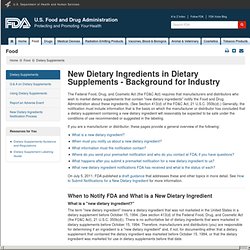
(See Section 413(d) of the FD&C Act, 21 U.S.C. 350b(d).) Generally, the notification must include information that is the basis on which the manufacturer or distributor has concluded that a dietary supplement containing a new dietary ingredient will reasonably be expected to be safe under the conditions of use recommended or suggested in the labeling. If you are a manufacturer or distributor, these pages provide a general overview of the following:
Potassium hydroxide. Magnesium hydroxide. Is an inorganic compound with the chemical formula Mg(OH) 2 . Maqui Berry: The Newest Superfruit. By this point, we have been liberally inundated with tales of super fruits, specifically super berries.
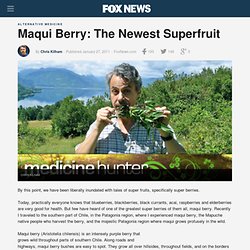
Today, practically everyone knows that blueberries, blackberries, black currants, acai, raspberries and elderberries are very good for health. But few have heard of one of the greatest super berries of them all, maqui berry. Recently I traveled to the southern part of Chile, in the Patagonia region, where I experienced maqui berry, the Mapuche native people who harvest the berry, and the majestic Patagonia region where maqui grows profusely in the wild.